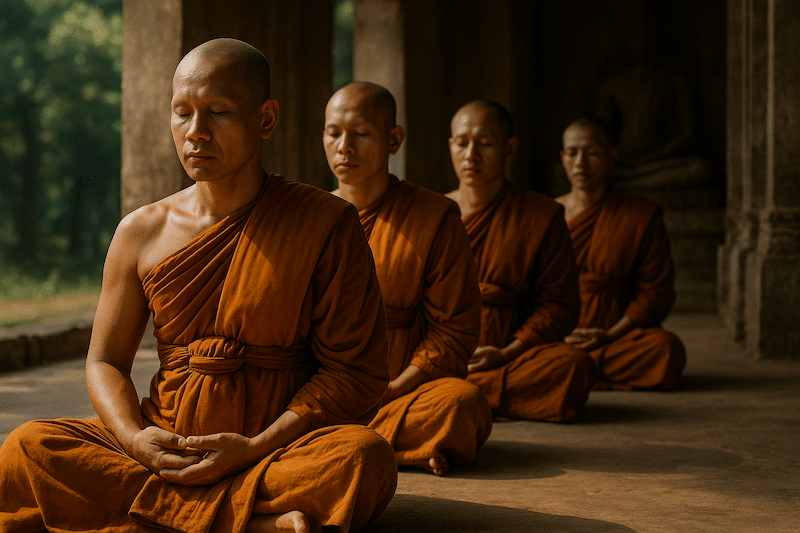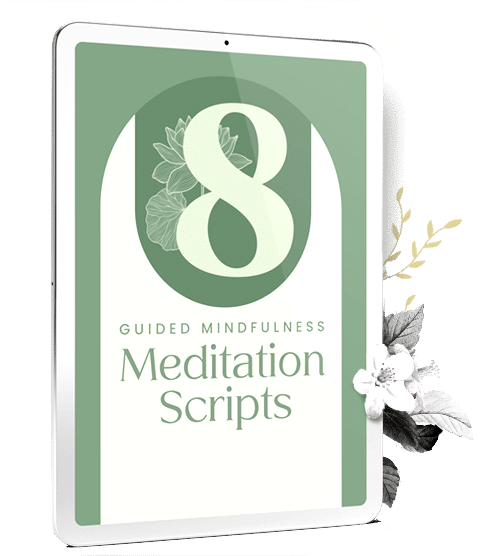People practice meditation to feel better. The benefits of meditation may include reduced stress and anxiety, improved clarity and focus, and a greater sense of happiness and well-being. Buddhists practice meditation with these intentions and more. For a Buddhist, meditation is the process of training the mind to bring about the end of suffering, revealing heaven on earth, or nirvana.
Buddhist meditation is just one part of a three-part training that includes ethics, meditation, and wisdom. Wisdom arises in a calm, stable and loving mind. We awaken to the truth that our own thoughts and actions are at the root of all our suffering. This same three-fold training is also the path to freedom from this suffering. When we live with greater kindness, and a more tranquil, less reactive mind, we perceive ourselves, others and everything in our world much differently. We live with greater peace and happiness, having awakened, or become enlightened, to the true nature of all things.

What Is Buddhist Meditation?
There are several different schools of Buddhism. Each has developed over thousands of years, influenced by the culture and great philosophers and practitioners of their time. Different Buddhist traditions may emphasize different types of Buddhist meditation. At their core, however, every Buddhist meditation technique serves to train the mind in the development of wisdom and compassion.
Most Buddhist meditation training begins with concentration practice. We learn to place the mind on a single object and hold it there. With practice, this style of meditation develops a calm and steady mind that’s more capable of focusing. A focused mind is necessary for more advanced Buddhist meditation techniques, which include contemplative and analytical practices.
The following are just a few of the most common styles of Buddhist meditation. Many will be familiar to non-Buddhists, as there’s no requirement to identify as a Buddhist to practice or benefit from these techniques.
Shamatha Meditation
The foundational practice of shamatha meditation settles and stabilizes the mind. Sometimes called Calm Abiding, shamata typically involves resting the mind on an anchor such as the breath, to develop the skill of concentration. Buddhists often choose an image of a Buddha or another holy object as their meditation anchor.
Vipassana Meditation
Vipassana meditation (known as vipashyana in Sanskrit) is a more advanced practice that involves discernment or insight. It is considered advanced because one must first attain shamata to experience vipassana. In this special state of concentration, one is aware of the increasingly subtle details of an object. This higher level of perception may include insight into an object’s true nature.
Analytical Meditation
Vipassana meditation involves a certain type of contemplative focus. Using both body and mind, we’re invited to get increasingly curious about our experience. Other types of meditation are more directly analytical. Buddhists will typically contemplate philosophical questions or logical problems during meditation, including the following:
Compassion Meditation
There is considerable overlap between wisdom and compassion-based practices. Buddhist meditation is a holistic experience that involves not just the mind, but the heart and body. Compassion practices in particular serve to soften our hearts, inviting us to practice generosity, kindness and care. Practices to help us develop compassion include the following:

How to Practice Buddhist Meditation?
Many people who are new to Buddhist meditation begin with anapanasati, or mindfulness of breath. This practice, however, is not just for beginners. It offers an opportunity to develop deep levels of concentration and awareness that can give rise to profound insight.
Practicing consistently over time offers us an opportunity to observe the habitual movement of the mind, and to cultivate new, more beneficial patterns. Those new to meditation may benefit from a guide. More advanced Buddhist meditations may require the guidance of a Buddhist teacher.
Benefits of Buddhist Meditation
Although mindfulness meditation is the most-researched form of meditation, many of its benefits extend to Buddhist meditation too. Buddhist meditation may benefit the body and mind uniquely, especially when practiced as part of a greater spiritual path toward awakening.
Concentration and Attention
Buddhist meditation develops focus and concentration, and does so differently depending on the meditation type and the level of the practitioner. While those new to meditation may fatigue with intense efforts, experienced meditators benefit from increased wakefulness after meditation. Some types of Buddhist meditation activate the sympathetic nervous system, while others induce parasympathetic activity for greater calm and relaxation.
Sense of Self
Buddhist meditations guide us toward a new perception of the self. Ultimately, we become identified with the Buddha within. Meditation reveals no self that exists the way we have habitually imagined it to, as separate and unchanging. This realization of ‘no-self’ can be freeing or terrifying. While softening our self-centered focus is typically considered a benefit of Buddhist meditation, the negative experience of some offers insight into the challenges of isolating Buddhist meditation from a more comprehensive path of Buddhist teachings.
Understanding Compassion
Studies connect Buddhist compassion practices to increased empathy, happiness and reduced reactivity to stress. Compassion meditation reduces fear response even outside of meditation, suggesting the changes that take place during meditation are long-lasting.
Spiritual Growth
We may not yet be able to scan one’s brain for signs of enlightenment, but there are marked differences in the brains of lifelong meditators. The real reward of Buddhist meditation is unshakable happiness. But this is not exclusive to Buddhism. Spirituality, as defined by a connection to something greater than oneself, is a significant predictor of happiness and wellbeing.

The Role of Mindfulness in Buddhist Meditation
Mindfulness is not exclusive to Buddhist practice, but for Buddhists, mindfulness is both the path and the goal. Buddhist meditations use ever-deepening mindfulness to cultivate both wisdom and compassion. At the pinnacle of the two is total freedom from our suffering.
The Buddha taught the four foundations of mindfulness as instruction on where to place our focus during meditation. They are also a preview of the insights available to practitioners.
Tips to Beginners For Effective Buddhist Meditation
Buddhist meditation techniques for beginners include shamata, mindfulness of breath, mindfulness of the body, compassion practices, and even some analytical practices such as leisure and fortune. Beginners should keep the following tips in mind when practicing Buddhist meditation:
Buddhist Meditation FAQs
Is meditation Buddhist?
Not every style of meditation is Buddhist. Some types of meditation have Buddhist origins, while others don’t.
Which types of meditation are Buddhist?
What makes a meditation Buddhist is whether or not it is practiced by Buddhists. There are several different schools of Buddhism. Within each school, many styles of meditation are practiced. These include mindfulness meditations, concentration practices, analytical meditations, and heart-opening compassion practices.
Do you have to be Buddhist to meditate?
You don’t have to be Buddhist to meditate. It’s possible to practice a meditation of Buddhist origin (such as metta meditation) without being a Buddhist, just as it’s possible to pray without having any religious affiliation.
Is mindfulness Buddhist?
Mindfulness is not Buddhist, although the Buddha did talk about mindfulness. More specifically, the Buddha talked about sati, which is often translated as mindfulness, but also can mean ‘to remember.’
Is Buddhist meditation safe?
Buddhist meditation is safest when taught by a skilled, compassionate teacher. Any and all forms of meditation can lead to adverse experiences if, when we turn our attention inward, we find unresolved trauma, or if we practice too intensely or without the proper guidance.
How do you practice Buddhist meditation?
To begin practicing Buddhist meditation, find a trusted resource for guided meditation. You can find a Buddhist meditation teacher online or within your local Buddhist community.
Conclusion
Meditation is an important part of the Buddhist path, as it sets the foundation for a mind that’s capable of experiencing deep wisdom and compassion. When we live with greater clarity and care, we experience more peace and happiness.
There’s no need to be Buddhist to meditate and enjoy these benefits. Anyone can practice deepening mindfulness and opening their hearts for a life that’s full of joy and ease.














